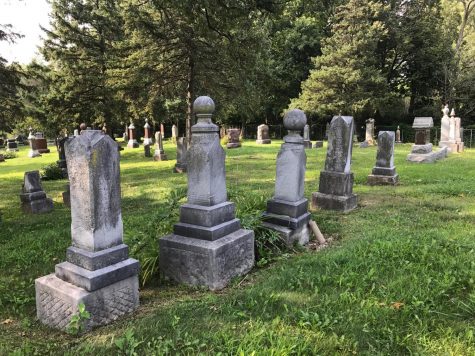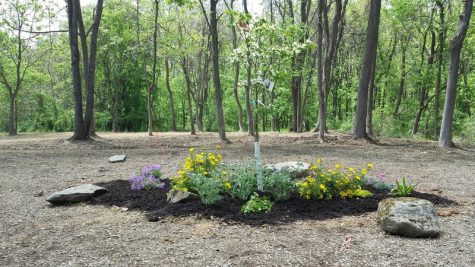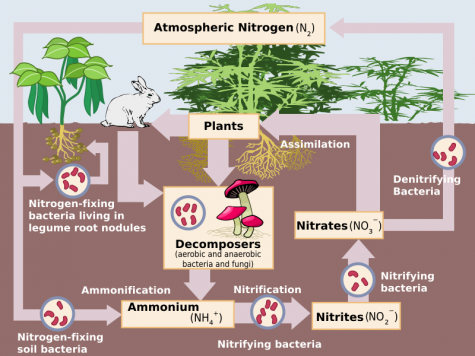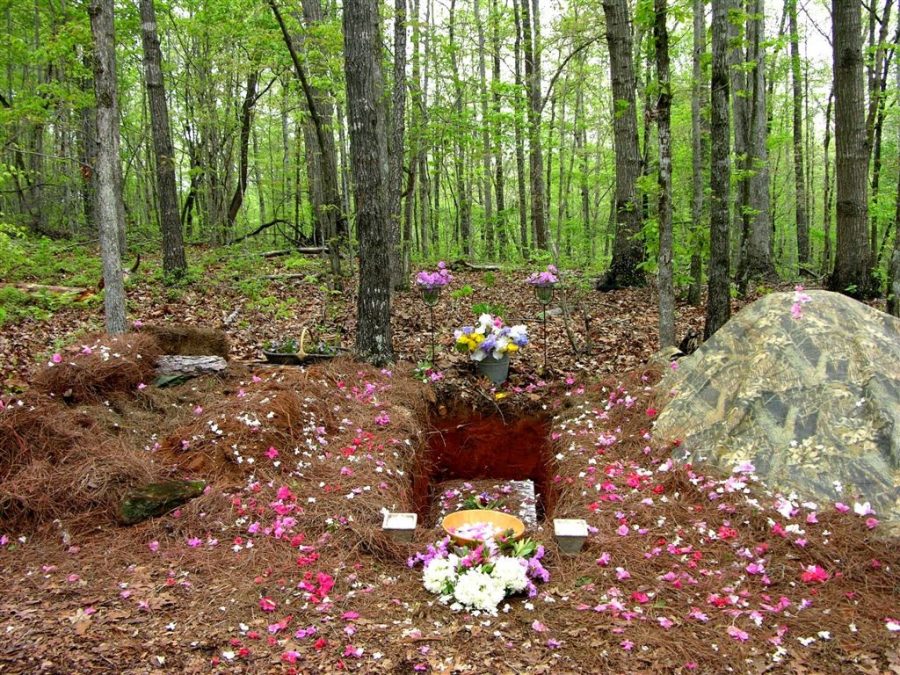Are we burying our dead wrong? (Exploring “green” burials as a sustainable alternative)
Photo provided by Marion Friel: Amongst other requirements, a true green burial contains no cement grave-lining and no traditional headstone. Immersed in nature, the burial comes to represent a celebration of the individuality of the deceased.
August 30, 2018
I picture myself, staring up, from down inside my satin-lined, stainless steel casket. Eyes sewn shut. Yet somehow, I can still see the silhouettes of those who loved me gathered above my bloodless body. Formaldehyde coursing through my veins, preserving my body, soon destined to disintegrate.
There has to be something more than this. Flesh to rot, bones to pile, littering my eternal prison-enclosed coffin.
Death cannot be a dead end.

Marion Friel is a funeral director and owner of Green Burials of Love in Chicago. She, along with an inspiring new wave, believes in the power of transferring one’s energy after death back into the environment.
“Green burials are centered on the ideas of reduce, reuse and recycle, all at the aim of reducing our carbon footprint. We use eco-friendly products to help the environment instead of hurting it. Along with the beauty of planting on top of grave-sites, we can make a wonderful difference,” said Friel.
Green burials place the deceased in sustainable, biodegradable caskets or urns, or wrapped only in a shroud. This enables the body to naturally break down, and the energy and nutrients of the deceased to transfer into the soil. From the soil, the nutrients and energy feed roots of flowers, vegetation or trees existing or planted on top of the gravesite.
Green and natural burials are a way to ensure the circle of life and the process of energy continue into the environment’s next generation.
In physics, the Law of Conservation of Energy states energy cannot be created nor destroyed. Energy can only be transferred or changed from one form to another.
Or as William Faulkner put it, “The past is never dead. It’s not even past.”
However, as Friel explained, “With traditional burials, your energy stays within the box because everything is so well preserved inside the casket and the concrete-lined vault.
“In a traditional cemetery, you are buried in a vault made of steel, copper or concrete, with Strentex liner designed to keep the concrete from becoming porous. Decomposition takes sometimes more than 60 years to occur in these situations. At 60 years, there might be only a little bit of mold growing on the body.”
According to the Natural Burial Company, every year U.S. cemeteries bury along with deceased:
-827,060 gallons of embalming fluid, 90,272 tons of steel (caskets), 2,700 tons of copper and bronze (caskets), 1,636,000 tons of reinforced concrete (vaults), 14,000 tons of steel (vaults), and 30-plus million board-feet of hardwoods (often treated wood for caskets)

In contrast, in a natural or green burial, the deceased can be buried in a shroud, or a biodegradable casket, made in varieties such as wicker, bamboo, seagrass, willow or untreated wood.
Friel explained an adaptation on Jewish and Islamic traditions, “Refrigeration units are used instead of embalming to keep the body preserved. A person can also be embalmed without replacing their pumped-out-blood with formaldehyde and methanol. Environmentally-friendly fluids can be used as an alternative.
“Natural burials can take place in traditional cemeteries, but green burials only occur in green cemeteries. They come with stricter environmental standards, such as using no artificial pesticides, and digging all graves by hand (without heavy machinery). Green cemeteries often prohibit types of clothing and jewelry the body can be buried with, trying to be cautious of every environmental impact.
“A green cemetery does not use traditional headstones. There are boulders or arranged flagstone to memorialize the deceased. Families can also plant a tree, flowers or beautiful ground cover above the gravesite to personalize the person’s resting place. Some green burials sites even have a memorial wall with the names of those in the park, with GPS locating to help find the gravesite.
“Biodegradable caskets only take a couple of years to break down. It takes 12-20 years for the whole body to disintegrate, leaving only the bones of the deceased, while the body’s energy and nutrients are free to move on,” said Friel.
College of DuPage Biology Professor Lynda Randa explained, “A green burial may not only enable us to expedite our return to the earth but can reduce our environmental impact if we avoid (harmful carcinogenic) embalming chemicals and encasement in traditional vaults and caskets.”

Elaborating on Friel’s reduce, reuse, recycle mantra, Randa explained, “Living organisms transform energy while incorporating and releasing various materials from the environment. The process of decomposition affords us a final opportunity to recycle some of the materials we assimilated during life. Nitrogen, found in DNA and proteins so necessary to life on Earth, is one key element we can recycle in this way.”
There is a biological flaw inherent in traditional burials, as College of DuPage Professor of Microbiology Karen Persky explained, “Microbes decompose all dead bodies of plants and animals. In a world devoid of bacteria and fungi, nitrogen would be tied up in the bodies of dead matter and be unavailable for new life. The nitrogen cycle would cease.”
Accommodating to different types of ecosystems, Friel explained, “A new trend in the industry is the burial of bodies deep inside woodlands on forest preserves. Workers pile on new dirt to help keep the ground level, and it helps preserve the ecosystem of the forest preserve. It will be interesting to see if Illinois ever considers this idea given the vast amounts of land in our forest preserves (popular in the United Kingdom).”
Professor Randa believes, “In many environments, certain kinds of flies and beetles accelerate decomposition.”
Unfortunately, a problem with green burials is the scarcity of available green cemeteries. There are currently 37 green or hybrid cemeteries located in 23 states.
However, Friel explained, “For clients who already purchased a traditional grave, in a traditional cemetery, there are eco-friendly options.
“Every traditional cemetery requires a grave-liner, which is a concrete box which goes inside the grave to keep the ground level. This creates the vault. The ground is kept level to prevent headstones from tipping. There are no concrete grave-liners in a green cemetery. However, this is prohibited in a traditional cemetery because of the heavy-equipment driving overhead to dig new graves. The grave vaults help keep the ground from collapsing under the immense weight and keep pressure from causing the caskets from rupturing under the ground.
“Environmentally-conscious people in traditional cemeteries can choose a vault not designed to preserve the body, but with a porous-concrete-liner only designed to keep the ground level.”
She also explained, “For clients who wish for a greener cremation, there is the eco-friendly process of alkaline hydrolysis.”
Traditional cremation burns fossil fuels, emits mercury when a person’s dental amalgam fillings are burned, and releases dioxin into the atmosphere when the plastic bag holding the body is consumed in flame.
However, Friel explained, “Alkaline hydrolysis uses water and alkaline instead of fire to degrade the body. Therefore, pollution isn’t emitted into the atmosphere. The skin and tissue will come off the body, however, even in traditional cremation, the bones need to be pulverized. Users claim the ashes from alkaline hydrolysis are whiter than traditional cremation because they haven’t been put through flames. These purer ashes can be spread into the environment, or placed in a biodegradable urn. I’ve even seen biodegradable urns made out of a type of sand. Biodegradable urns are fantastic; however, you cannot get them wet, for obvious reasons.
“The bones and ashes of the body in cremains can aerate and provide nutrients to the soil.
“Other eco-innovations include placing the body in a mesh-shroud placed directly under the roots of a tree, or even, soil injections allowing cremains to be directly fed into the roots of an existing tree,” said Friel.
The ability to think outside the box can inspire both public efforts and city planners to help conserve more natural land.
Friel stated, “Green burial cemeteries come to resemble a forest preserve. They are beautiful. You can walk around, meditate, or just enjoy nature. I personally would love to begin a new green cemetery. Maybe repurpose an old cornfield, which already has the proper drainage, and create it into something beautiful.
“Clay in the soil is a necessity for green burials. It absorbs anything potentially bad from the bodies. The nutrients are fed through the clay into the soil, allowing new life to grow.”
With the continuance of life, people feel a greater connection with the place their loved one was laid to rest.
Solace is about reaching a greater existential understanding and appreciation for the person’s life and the cycles that flow through our existence.
Friel reflected, “If someone can tell me at the end what a beautiful service it was, it’s an amazing feeling. It’s wonderful to help people in need and help them feel comfort in a trying time. People come to me in tears but leave with a feeling of reassurance on life.
“I once had a family who told me they just wanted to have a celebration-of-life party. They needed the solace of having a place to celebrate and being together with loved ones and family.
“Most people aren’t always sitting in the funeral home crying. Death can bring people together who have been apart for a long time. When we see all these loved-ones come together, it becomes a celebration for people to embrace. It honors the life of the deceased.”
Emily Dickinson once wrote of death as, “The sweeping up the Heart, and putting Love away.”
As I stand before my grandmother’s final resting place. A mausoleum. Trapped behind a wall of marble and concrete. A woman who loved flowers and adored sunshine. I can’t help wondering, what divine transcendence has been lost?


















